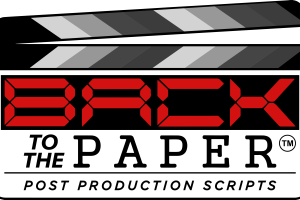In 2020, the film industry generatedabout $25.9 billion.
That’s a lot of money, but making the larger chunk of this change is more than about raw filmmaking talent. It’s about preparing your film for distribution, a process involving a dialogue list.
A dialogue list is a paper copy of the final video asset. It also makes it easier for the network or distributor to watch the film, take notes, suggest edits, and easily access the entire story. Having a dialogue list can particularly help with subtitling and foreign translation, which helps in the distribution and airing of your film.
Keep reading to learn more. Below, we’ll explain dialogue lists — from their primary function, why they’re necessary, to actually making one yourself.
Dialogue List — Overview
A dialogue list is a time-coded post-production script. Time codes mark the beginning and end of when sound or dialogue occurs in a movie.
It would be submitted to television or cable networks or film distributors as part of the distribution package for the film. Dialogue lists are commonly used in translation to assist translators in creating a spotting list (subtitle file) for foreign languages.
What Dialogue Lists Look Like
There isn’t one perfect dialogue list format. But generally, the dialogue lists will ask for the following information:
- Character name
- Timecode in
- Timecode out
- Duration
- Dialogue text
Some templates incorporate other features to specify dialogue in greater detail. But generally, these are the essential pieces of information included in nearly every dialogue list template. Dialogue lists may consist of this information:
- Lyrics
- Music description
- On-screen graphics, signs, text
- Sound effects
- Spoken dialogue
- Vocal sounds
- Voiceovers
Dialogue lists are typically formatted and downloaded in Microsoft Word .docx format. However, many dialogue lists are also generated as PDF and XLS files.
Other Types of Post-Production Lists
Post-production scripts differ from original screenplays in function, content, and script format. At this point, the screenplay — or a shooting script — would have likely been revised and edited, therefore making them unsuitable to use for creating dialogue lists. These are the four other most popular post-production scripts sent to production and network companies.
As-Broadcast Scripts (ABS)
An as-broadcast script is written like a screenplay. Unlike other post-production scripts, it doesn’t include technical details involving camera movement and angle. Instead, it details scene visuals from the beginning to the end of a scene rather than from cut to cut — “as-broadcast.”
Combined Dialogue and Spotting List (CDSL)
You could say that a combined dialogue list and a spotting list is a dialogue list on steroids. It’s a script that combines dialogue and spotting functions that do not describe the film’s visuals. In post-production, subtitles are also known as “spots,” which is why the process of creating this list is called “spotting.”
The movie’s entire dialogue is written instead. This dialogue will also be used for a spotting list.
Combined Continuity and Spotting List (CCSL)
A combined continuity and spotting list describe audible and visual moments on screen in their technicalities. These visual descriptions are also known as “continuity.”
As opposed to as-broadcast scripts, CCSLs will technically describe every scene shot. Each shot will be coupled with detailed shot explanations that describe camera angles, on-screen action, aesthetics, and so on.
All this, as well as a spotting portion. Spotting portions are also usually accompanied by dialogue portions, making this one of the most comprehensive post-production scripts.
Benefits of Dialogue List Templates
But why should you bother with making a dialogue list? And how can a template get you ready for distribution?
Accessibility
There are many ways to improve the accessibility of the film-viewing experience. Creating dialogue lists for your movies is just one of them, but it’s a significant step. Subtitlers use these dialogue lists to create closed captioning on screen.
No one can fully enjoy a movie that they can’t understand. Those that are hard of hearing may not understand your film if it can only be heard.
It’s fairer to try and include this demographic in your viewership. Otherwise, their options to enjoy the arts are further limited. That’s why they must be able to read accurate closed captioning, which is primarily possible from dialogue lists.
Not to mention, many people who are not hard of hearing also prefer closed captioning. While most big screen aficionados won’t boycott a movie because of a lack of closed captioning, it could slightly diminish their experience if they expected to stream with subtitles.
Saves Time
There are various other post-production scripts filmmakers and producers can use. But dialogue lists are simple but effective enough for most filmmakers to use.
A lot of training and expertise is involved in creating an ultra-comprehensive post-production script. However, doing dialogue lists yourself strikes a happy medium between efficacy and peace of mind for those in charge of film production. You could even complete a CCSL if you wanted something that also allows technical details to shine through.
Collaborating with third-party experts can also help. However, you might need to get started on the list sooner than you can find a professional. Luckily, even novices can get the hang of creating dialogue lists, so don’t hesitate to create one for your own work.
Timeliness is critical for any endeavor, including during post-production crunch time. Film festivals have submission deadlines, and network distributors won’t wait around, either. If you can finish your own dialogue list in time, save yourself some trouble and do it yourself.
Cost Efficiency
As mentioned before, it’s possible to hire professionals for your project. But you, like many other filmmakers, might be running operations on a tight budget and don’t want to overextend it.
Especially since you’ll want to set aside some funds for a translator. The translator will use your dialogue list to create the translations required for a spotting list, which will be helpful when submitting your work to film festivals, global distributors, and more.
Completing a dialogue list yourself isn’t an impossible process and could help save a lot of money. If finances are a priority, create the list yourself and use the remaining funds to invest in a bigger project.
Quality Control
There are several strategies filmmakers can employ to hire the right professional for their dialogue list. But even then, there’s a chance that you won’t gel well with the person you’ve hired. You may even find that they don’t double-check their grammar and spelling.
Sometimes, it’s easier to perform specific tasks yourself, especially with grammar-checking tools that even professionals use. If you already know you’ll do a decent job, why not? You’ll save money, time, and a potential world of headaches by doing so.
Down the line, you’ll probably take on a project well-funded enough for the best people in the industry. But for now, scrimp and save where you can while ensuring the quality you expect from any documents affiliated with your work.
Ease of Use
Those who haven’t created post-production scripts before might not know where to start. They may be unsure about what information to incorporate or what interface to log this information.
By definition, templates do precisely that. Great dialogue list templates also look polished, clean, and easy to use.
There’s no need for any specific pieces of technology or software. You won’t have to clutter up a device with new programs taking up memory and won’t have to dish out your funds for a fancy piece of hardware.
Instead, you can simply open up the document and your film before writing away. This could be done in virtually any working environment too, which is excellent for anyone who likes editing and doing paperwork in bed or a coffeehouse.
Streaming Opportunities
Being showcased on a streaming service indicates that the service in question trusts your work will engage its viewers. But they won’t have that trust if you can’t provide subtitles. Most, if not all, works on top streaming sites have subtitles to reach a wider audience.
Films and TV shows from major networks will nearly always attach a comprehensive post-production script, such as a CCSL (combined continuity and spotting list) to these services. The availability of streaming services is especially competitive for smaller filmmakers. It’s unlikely one will rise above their competition without a post-production script.
You’re likely interested in expanding your film’s distribution to streaming services. If that’s true, make sure you have a dialogue list.
Globalization
A dialogue list is necessary to reach out to additional distribution channels. That’s because industry executives need a dialogue list to understand the movie’s plot and narrative.
Globalizing your work isn’t easy without subtitles in the viewers’ local language. Subtitling also isn’t easy without a dialogue list. If you’re interested in working with global film distributors, submitting your film to international film festivals, or uploading it on YouTube for the world to see, make sure speakers of various languages can understand it.
Your film might also become very popular in a different country than it does domestically. Though the lack of domestic success may seem discouraging at the moment, it’s still a success. Success in another country could also be a critical stepping stone to eventually gaining domestic recognition.
Of course, your film could also do well domestically and internationally. In that case, you’ll want to maximize this potential by ensuring it’s internationally accessible.
Tips for Creating Great Dialogue Lists
Now you know why creating a great dialogue list is critical for your film’s growth. However, you might still be unsure if you’re ready to take the task on.
Creating an excellent dialogue list doesn’t have to be a daunting task. But for those who aren’t sure how to get started, we’ve got a few tips on writing an effective dialogue list. By following them, you’ll be in a lot better shape to finally finish up post-production and prepare your movie for the masses.
Double, Triple, and Quadruple Check
Needless to say, for a document that you’re potentially sending along to industry executives, accuracy is critical. Using a dialogue list for a YouTube upload contains less pressure due to the subtitles’ editability. But it can still be irritating to have your film’s debut sullied by inaccurate timecode logs, spelling and grammar errors, and typos.
You might need to pore over your movie to rectify any inaccurate timecode logs. Perhaps the list will be double-checked by multiple people before it’s deemed ready to go.
If you’re a filmmaker creating a dialogue list, you’ve likely already got some essential writing chops and are less likely to create spelling and grammar errors, and typos in the first place, especially since you’re using the screenplay as a touchstone. But whether or not you’re a decent writer, use a professional grammar-checking tool on the document.
Don’t let it alter the actual dialogue being transcribed. However, it can catch any spelling and grammar errors in the document.
Specify Details
There’s little need for unique descriptive detailing when transcribing dialogue. But as mentioned before, dialogue lists can also describe SFX sounds, end-credit scenes, etc. The descriptions must be specific enough to properly immerse viewers who aren’t listening to the movie.
Specification doesn’t have to come in the form of prolific verbiage. Instead, it could come in the form of proper word choice.
Replace rain “falling” with rain “pouring” or “lightly pittering.” Though you could describe a cough as just that, a “cough,” you could also call it a “hacking cough” or a “light cough.”
This is one of the more stylistic parts of creating a dialogue list, but it’s not about making your prose look pretty. It’s about correctly communicating the aesthetic events of your movie to your film’s audience.
Browse Our Professional Dialogue List Templates!
No more leaving captioning, translation, etc., to inconsistent quality control. Instead, you can ensure that foreign language translations are accurate, making your work more accessible around the globe.
At Back to the Paper, we understand the importance of a film reaching a broad audience. That’s why we offer plenty of professional, sleek dialogue list templates! Check them out today.



